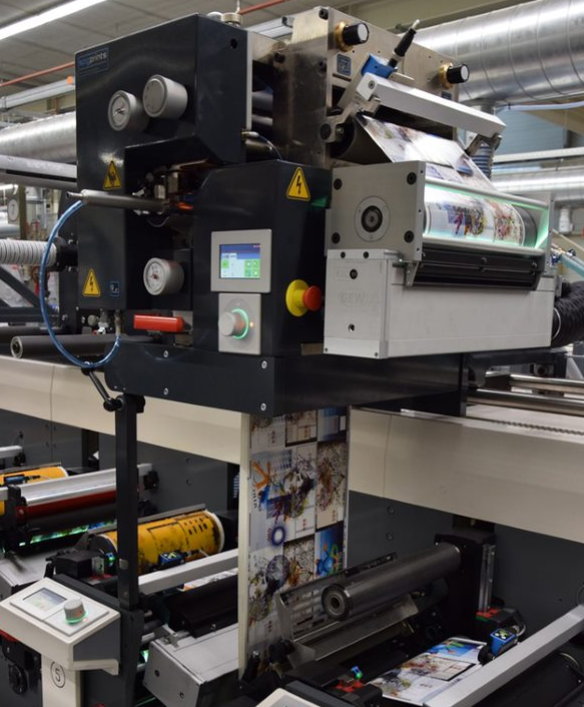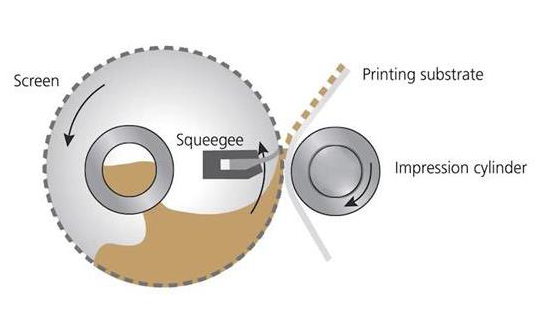Rotary screen printing is an embellishment process that helps make a label stand out and gives it a unique look. It gives the label an embossed feel (without the embossing process) to add texture and feel to the product, which is appealing to consumers.
There are many effects and uses for rotary screen printing, such as security features for wine labels (that I’m not able to talk about because of intellectual property). Screen printing offers the same print quality as flat-bed screen printing, but in a cylindrical form.
It’s very common for either a combination or fixed unit press to have a rotary screen unit. A rail system is an advantage for the flexibility to move the unit where needed. A insert screen unit is also available and goes on to a flexo unit and uses the UV of the flexo unit and offers a shorter web path.
Common Uses for Rotary Screen Printing:
- High build varnish (embossed effects)
- Special effect varnish e.g., glitter with varnish
- White solid text with a textured feel
- Electrical circuit boards
- Security features
- Large quantity production

Screen-Making Process
Step one: It’s important to select the right screen for your job during the screen-making process. This includes the type of screen, whether it’s a reusable or a single-use mesh.
Step two: The screen can be made flat then applied to the ring ends. You can also make them round and expose the image in-house or you can buy them pre-made with your image on the screen.
The screen line count of the mesh depends on the type of job you are running. Jobs with small or large type, varnish spot or large area varnish, screen or line work, and special applications all require a different screen count. If the amount of ink is thick, a larger mesh screen is required. A thin line or small type would require a smaller mesh screen.
Step three: The screen is coated with an emulsion and can be exposed with light and a film with the image and digital (laser etched). Once exposed, it will need to be washed, checked for pinholes, then placed in a drying cabinet before being ready for use.
If you want to make high quality screens, you need specifically made pre-press equipment and trained personnel to operate it. To reuse a screen, apply a special paste to break down the emulsion before washing and drying the screen. Then apply the emulsion with the aid of an applicator and let dry. The emulsion is ready to be used again on the next job. The screen can also be washed after use and stored for the next run.

Rotary Screen-Printing Process
The screen-printing process is a screen mesh-like flatbed but in a cylindrical form, which allows it to run in-line with your MPS label press. The screen unit consists of a screen holder, screen, squeegee blade, and ink or varnish.
Ink is pumped in through the squeegee holder. After the screen is installed, mount the squeegee blade. This is a stainless-steel blade with a polyurethane strip. The squeegee remains in contact with the screen to wipe off the excess ink and regulate the ink applied to the substrate. (Hint: never put the squeegee on a dry screen as this can damage and rip the screen.)
The pressure and angle of the blade is also very important. To achieve a clean print, always start with the pressure gage at zero. The selection of the blade and shore hardness can also influence the final print quality.
Different colours and hardness determine if the screen is used for fine type and lines, opacity, glitter effects, and even braille. Proper selection of the squeegee blade and correct set up in the squeegee gig is also very important for the best wipe and printing result.
It’s possible to adjust the gap between the screen and substrate, depending on the thickness of the substrate. Once set for your job, do not adjust the gap while running as this will reduce the life of the screen.
Screen Ink
The ink and its condition is very important.
It needs to be free of silicon and contaminates or this will cause pinholes and issues with the laydown. If problems occur, the ink must not be used. The screen needs to be thoroughly cleaned.
It’s best to take the screen to pre-press and have it cleaned in the screen washer, as it’s easy to damage and crease a screen when cleaning it by hand.
There are many available inks for screen printing and all have their different uses. High build varnish is popular because it provides an embossed look and feel without the need of an embossing unit.
Adding glitter to a varnish can give different effects depending on the colour. A starlight effect can be achieved with silver glitter. White is very common for type or barcode areas because it is very opaque and bright while having a textured feel. Many more inks, such as electrically conductive ink, can be used for touch screen and flexible circuit boards.
There is an ink for all your needs. Contact your ink suppliers for more information.
Learn more about ink and basics of colour matching.
The topic of screen printing is simple in design but can be very complex from pre-press to the printing process. This is just a small snippet of my experience in rotary screen printing.
If you have any questions, suggestions, or issues, please feel free to contact me at any time.
